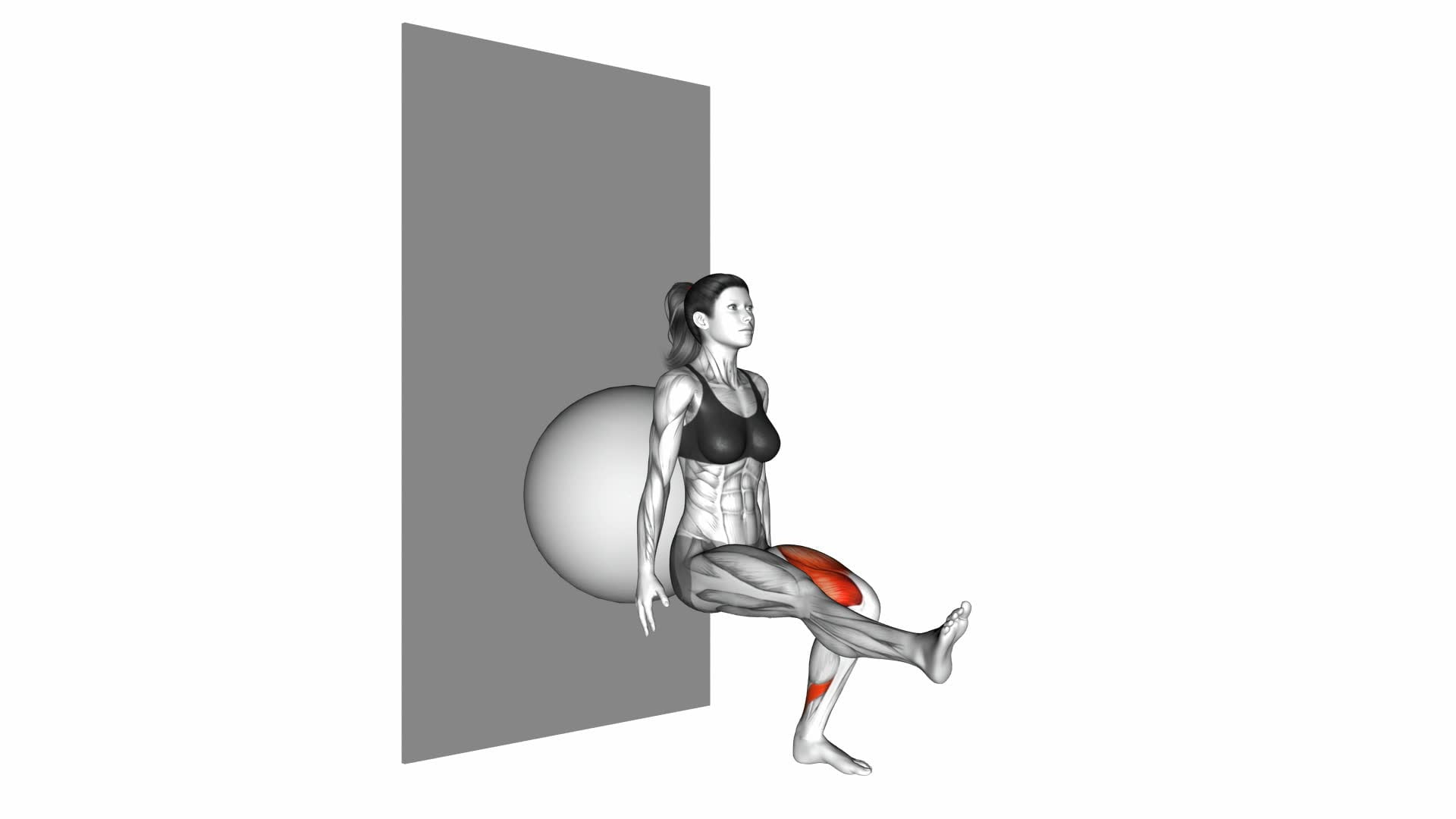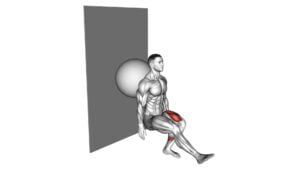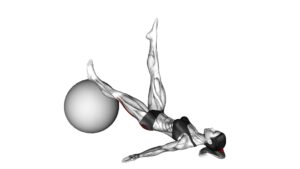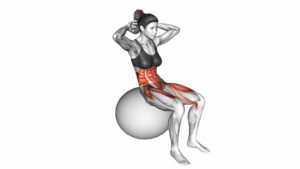Stability Ball Single Leg Squat – Video Exercise Guide & Tips

Get ready to take your leg workout to the next level with the Stability Ball Single Leg Squat. This challenging exercise targets your glutes, quads, and hamstrings while also improving your balance and stability.
Watch This Exercise Video
With just a stability ball, you can perform this effective exercise at home or at the gym. In this video exercise guide, you'll learn the proper form and technique, as well as helpful tips and modifications to maximize your results.
Start squatting with confidence and see the benefits for yourself.
Key Takeaways
- Stability Ball Single Leg Squat targets glutes, quads, and hamstrings.
- It improves balance and stability.
- Engaging core muscles is a key component of this exercise.
- Stability Ball Single Leg Squat enhances overall fitness level and is beneficial for sports and everyday movements.
Benefits of Stability Ball Single Leg Squat
You can experience improved balance and core strength through the use of a stability ball during single leg squats. Stability ball exercises, such as single leg stability exercises, are a great way to challenge your body and enhance your overall fitness level. When performing single leg squats on a stability ball, you engage your core muscles to maintain balance and stability throughout the movement.
The instability of the stability ball forces your muscles to work harder, as they constantly adjust and stabilize your body. This not only targets your leg muscles, but also activates your core muscles, including your abs, obliques, and lower back. By incorporating stability ball single leg squats into your workout routine, you can improve your balance and coordination, which can be beneficial for various activities, such as sports and everyday movements.
In addition to the physical benefits, stability ball single leg squats can also help with injury prevention. By strengthening the muscles in your legs and core, you can improve your stability and reduce your risk of falling or getting injured. This exercise is especially beneficial for those recovering from ankle or knee injuries, as it helps to improve joint stability and increase overall strength.
Now that you know the benefits of stability ball single leg squats, let's move on to the equipment needed for this exercise.
Equipment Needed for Stability Ball Single Leg Squat
To perform a Stability Ball Single Leg Squat, there are a few essential pieces of equipment you'll need.
First and foremost, you'll need a stability ball. This inflatable ball provides an unstable surface, challenging your balance and engaging your core muscles.
If you don't have access to a stability ball, you can use alternatives like a BOSU ball or a foam pad. However, keep in mind that the benefits of using a stability ball include improved balance, increased core strength, and enhanced stability.
Essential Equipment for Stability Ball Single Leg Squat
To perform the Stability Ball Single Leg Squat, you'll need specific equipment. The essential equipment for this exercise includes a stability ball and a clear space to perform the workout.
The stability ball, also known as a Swiss ball or exercise ball, is a large inflatable ball that adds an element of instability to your workout, engaging your core muscles and improving balance. It's commonly used in stability ball exercises and stability ball workouts to target various muscle groups, including the legs, glutes, and core.
When choosing a stability ball, make sure it's the appropriate size for your height. It's recommended to consult with a fitness professional to determine the correct size for you.
Alternatives to Stability Ball
If you don't have a stability ball, an alternative piece of equipment you can use for the Stability Ball Single Leg Squat exercise is a BOSU ball. The BOSU ball is a versatile piece of equipment that can be used for a variety of stability exercises.
It consists of a flat platform on one side and a dome on the other, providing an unstable surface that challenges your balance and engages your core muscles.
To perform the Single Leg Squat on the BOSU ball, stand on the flat platform side with one foot while keeping the other foot lifted off the ground. Slowly lower yourself into a squat position, keeping your balance and control.
This variation provides a similar challenge to the stability ball exercise, targeting your leg muscles and improving your stability and balance.
Other stability ball alternatives include using a balance disc or a foam pad to perform similar variations for stability ball exercises.
Benefits of Using Stability Ball
Using a stability ball for exercises like the Stability Ball Single Leg Squat can provide numerous benefits and requires the proper equipment. Here are four key benefits of incorporating stability ball exercises into your workout routine:
- Improved Core Stability: Performing exercises on a stability ball engages your core muscles to maintain balance and stability. This helps strengthen your core and improves overall stability and posture.
- Increased Muscle Activation: Using a stability ball adds an element of instability to your exercises, which forces your muscles to work harder to maintain balance. This can lead to increased muscle activation and a more effective workout.
- Enhanced Balance and Coordination: Regularly incorporating stability ball exercises into your routine can improve your balance and coordination. This is especially beneficial for athletes or anyone looking to improve their athletic performance.
- Low-Impact Workout Option: Stability ball exercises are generally low-impact, making them a great option for individuals with joint issues or those who prefer a gentler workout. The stability ball provides support while still challenging your muscles.
Incorporating stability ball exercises into your workout routine can provide numerous benefits, including improved core stability, increased muscle activation, enhanced balance and coordination, and a low-impact workout option. Make sure to use the proper equipment and consult with a fitness professional to ensure proper form and technique.
Proper Form and Technique for Stability Ball Single Leg Squat
Maintain a stable and balanced position while performing the Stability Ball Single Leg Squat. This exercise is an excellent way to target your lower body muscles while also improving your core stability. The stability ball adds an element of instability, forcing your muscles to work harder to maintain balance throughout the exercise.
To perform the Stability Ball Single Leg Squat with proper form, start by standing in front of the stability ball with one foot resting on top of it. Extend your arms out in front of you for balance. Slowly lower your body down into a squat position, keeping your weight on your standing leg. As you lower, focus on keeping your knee aligned with your toes and your back straight. Once you reach a comfortable depth, push through your standing leg to return to the starting position.
Maintaining proper stability ball form is crucial to maximize the benefits of this exercise. Keep your core engaged throughout the movement to stabilize your body. Avoid excessive leaning or tilting to one side. If you find it challenging to balance on the stability ball, start with a smaller range of motion and gradually increase it as you gain strength and stability.
In the next section, we'll discuss modifications and progressions for the Stability Ball Single Leg Squat, which will help you continue challenging your muscles and further improve your balance and stability.
Modifications and Progressions for Stability Ball Single Leg Squat
Looking to modify or progress your stability ball single leg squats?
There are easier modification options available for those who are just starting out or need additional support.
On the other hand, if you're looking for a challenge, there are advanced progression variations that can take your single leg squats to the next level.
Whether you choose to modify or progress, incorporating single leg squats into your workout routine can help improve balance, stability, and leg strength.
Easier Modification Options
Start with a chair. If you find the Stability Ball Single Leg Squat too challenging, there are easier modifications you can try. These modifications will help you build strength and improve your balance before progressing to the full exercise.
Here are four modification options to consider:
- Chair-Assisted Single Leg Squat: Use a chair for support while performing the exercise. This will help you maintain proper technique and stability.
- Partial Range of Motion: Instead of squatting all the way down, only lower yourself partway. This reduces the demand on your muscles and makes the exercise easier.
- Two-Legged Squat: Begin by performing the exercise with both feet on the ground. This provides more stability and allows you to gradually work up to the single leg version.
- Wall Squat: Stand with your back against a wall and perform the squat with support from the wall. This helps you maintain balance and control throughout the movement.
Advanced Progression Variations
To progress further in the Stability Ball Single Leg Squat exercise, you can explore advanced variations that challenge your strength and balance. These advanced modifications will take your workout to the next level and help you continue to improve.
One advanced variation is the Stability Ball Pistol Squat. This exercise requires even more balance and core stability as you lower yourself down into a deep squat on one leg while keeping the other leg extended in front of you.
Another advanced variation is the Stability Ball Single Leg Squat with a Medicine Ball. Holding a medicine ball in front of you adds an extra challenge to your core and upper body as you perform the squat.
These advanced variations will help you further develop your strength, balance, and overall fitness level.
Benefits of Single-Leg Squats
As you explore the advanced variations of the Stability Ball Single Leg Squat, you'll discover the numerous benefits and modifications that can be incorporated into this exercise.
Here are four advantages of incorporating single-leg squats into your workout routine:
- Improved balance and stability: By performing single-leg squats, you challenge your body to maintain balance and stability, which can help improve your overall coordination and proprioception.
- Increased leg strength: Single-leg squats primarily target the muscles in your legs, including your quadriceps, hamstrings, and glutes. By strengthening these muscles, you can improve your overall lower body strength and power.
- Enhanced core engagement: Single-leg squats require significant core activation to maintain balance and stabilize your body. This can help strengthen your core muscles, leading to improved posture and stability in other exercises and daily activities.
- Injury prevention: Single-leg squats can help identify and correct muscle imbalances and weaknesses in your legs. By addressing these issues, you can reduce the risk of injuries, such as ankle sprains and knee pain.
While there are many advantages to single-leg squats, it's important to be aware of the potential disadvantages. These can include increased stress on the knees and difficulty maintaining proper form. It's essential to start with proper progressions, seek guidance from a qualified trainer, and listen to your body to avoid injury and maximize the benefits of this exercise.
Common Mistakes to Avoid During Stability Ball Single Leg Squat
One common mistake to avoid during the Stability Ball Single Leg Squat is leaning too far forward. Maintaining proper form is essential for getting the most out of this exercise and preventing injury. Leaning forward can put excessive strain on your lower back and shift the focus away from your glutes and quads, which are the primary muscles targeted in this exercise. To avoid this mistake, make sure to keep your torso upright throughout the movement. Engage your core and imagine a straight line from your head to your knee.
Another common mistake isn't fully extending your supporting leg. It's important to fully extend your standing leg at the top of the squat to activate your glutes and maximize the effectiveness of the exercise. Additionally, avoid rushing through the movement. Take your time and focus on controlled, slow movements to engage the targeted muscles properly.
Lastly, don't forget to breathe. Proper breathing technique helps maintain stability and prevents unnecessary tension. By avoiding these common mistakes, you can optimize your stability ball single leg squats and achieve better results.
Tips for Getting the Most Out of Stability Ball Single Leg Squat
Maximize your results by following these three tips for getting the most out of the Stability Ball Single Leg Squat:
- Start Slow: When getting started with the Stability Ball Single Leg Squat, it's important to take it slow. Focus on mastering your form and balance before increasing the difficulty or adding weights. This exercise requires stability and control, so rushing into it can lead to injury or poor results.
- Engage Your Core: One common challenge with the Stability Ball Single Leg Squat is maintaining stability throughout the movement. To overcome this, focus on engaging your core muscles. This will help you maintain balance and control as you lower and lift your body.
- Keep Your Knee Aligned: Another common challenge is keeping your knee aligned during the squat. To ensure proper alignment, make sure your knee tracks in line with your toes as you lower yourself down. Avoid letting your knee collapse inward or extend too far forward, as this can put unnecessary strain on your joints.
- Listen to Your Body: As with any exercise, it's important to listen to your body and adjust as needed. If you're experiencing pain or discomfort, take a break and reassess your form. It's better to take it slow and make adjustments than to push through and risk injury.
Frequently Asked Questions
How Many Reps and Sets Should I Do for the Stability Ball Single Leg Squat?
To determine the number of reps and sets for the stability ball single leg squat, you should consider your fitness level and goals. Start with 2-3 sets of 8-12 reps per leg. As you get stronger, gradually increase the number of reps or sets.
Remember to listen to your body and make modifications if needed. Consulting with a fitness professional can also help you create a personalized workout plan.
Can I Do the Stability Ball Single Leg Squat if I Have Knee or Ankle Injuries?
If you have knee or ankle injuries, it's important to modify your workout routine.
The stability ball single leg squat may not be the best exercise for you in this case. However, there are modified versions of this exercise that you can try, which are easier on your knees and ankles.
Additionally, there are alternative exercises that can target similar muscle groups without putting strain on your injured joints.
It's always best to consult with a healthcare professional before starting any new exercise program.
Is It Better to Do the Stability Ball Single Leg Squat With Shoes on or Barefoot?
When deciding whether to do the stability ball single leg squat with shoes on or barefoot, consider the importance of proper form and technique.
Both options have their benefits. Wearing shoes can provide extra stability and support, especially if you have ankle or knee injuries.
However, going barefoot allows for better balance and engagement of the foot muscles.
Ultimately, choose the option that feels most comfortable and allows you to maintain good form throughout the exercise.
How Can I Incorporate the Stability Ball Single Leg Squat Into My Existing Workout Routine?
To incorporate the stability ball single leg squat into your existing workout routine, start by understanding the benefits of stability ball workouts. These exercises engage your core, improve balance, and strengthen your lower body.
Begin by placing the stability ball against a wall. Then, position one foot on top of the ball and slowly lower yourself into a squat position. Repeat on the other leg. Be sure to maintain proper form and control throughout the exercise for maximum effectiveness.
Can I Do the Stability Ball Single Leg Squat if I Don't Have a Stability Ball?
If you don't have a stability ball, you can still do the stability ball single leg squat by making a few modifications. Instead of using a stability ball, you can try using a bench or a step to provide stability and support.
Another alternative exercise to target similar muscles is the single leg squat without any equipment. Remember to maintain proper form and start with a weight that challenges you without causing any pain or injury.
Conclusion
Incorporating stability ball single leg squats into your workout routine can provide numerous benefits, including improved balance, core strength, and lower body stability.
With the right equipment and proper form, this exercise can be modified and progressed to suit your fitness level.
Avoid common mistakes and follow these tips to maximize the effectiveness of the stability ball single leg squat.
Start reaping the rewards of this challenging yet rewarding exercise today.

Author
Years ago, the spark of my life’s passion ignited in my mind the moment I stepped into the local gym for the first time. The inaugural bead of perspiration, the initial endeavor, the very first surge of endorphins, and a sense of pride that washed over me post-workout marked the beginning of my deep-seated interest in strength sports, fitness, and sports nutrition. This very curiosity blossomed rapidly into a profound fascination, propelling me to earn a Master’s degree in Physical Education from the Academy of Physical Education in Krakow, followed by a Sports Manager diploma from the Jagiellonian University. My journey of growth led me to gain more specialized qualifications, such as being a certified personal trainer with a focus on sports dietetics, a lifeguard, and an instructor for wellness and corrective gymnastics. Theoretical knowledge paired seamlessly with practical experience, reinforcing my belief that the transformation of individuals under my guidance was also a reflection of my personal growth. This belief holds true even today. Each day, I strive to push the boundaries and explore new realms. These realms gently elevate me to greater heights. The unique combination of passion for my field and the continuous quest for growth fuels my drive to break new ground.







